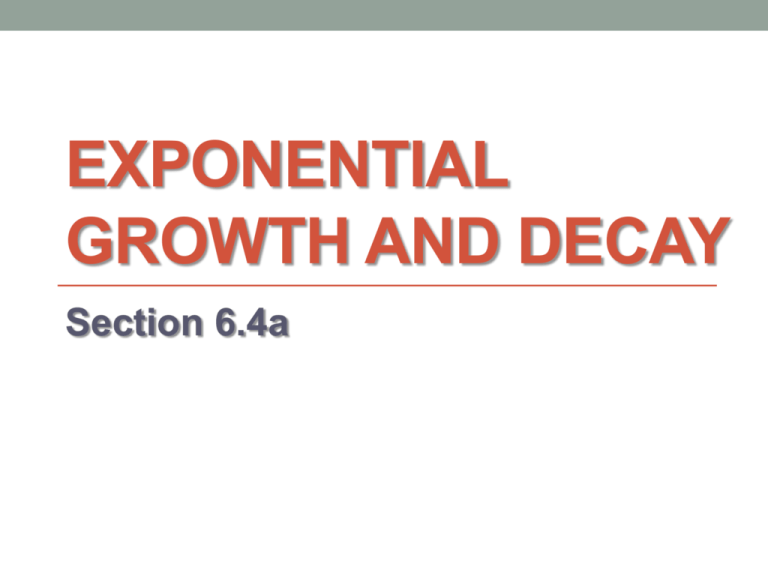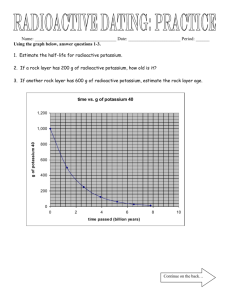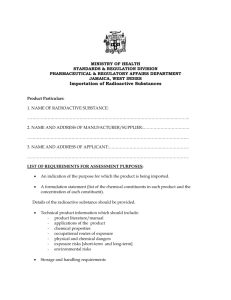Exponential Growth and Decay
advertisement

EXPONENTIAL GROWTH AND DECAY Section 6.4a Law of Exponential Change Suppose we are interested in a quantity y that increases or decreases at a rate proportional to the amount present… Can you think of any examples??? If we also know the initial amount of y , we can model this situation with the following initial value problem: Differential Equation: Initial Condition: y dy ky dt 0 y0 Note: k can be either positive or negative What happens in each of these instances? Law of Exponential Change dy Let’s solve this differential equation: ky dt dy kdt Separate variables y dy y kdt ln y kt C Integrate ln y e e kt C y e e C kt Exponentiate Laws of Logs/Exps Law of Exponential Change dy Let’s solve this differential equation: ky dt y e e C kt y e e Def. of Abs. Value kt C Let A = + e – y Ae k 0 y 0 Ae A y0 Apply the C Solution: y y0 e kt Initial Cond. kt Law of Exponential Change If y changes at a rate proportional to the amount present (dy/dt = ky) and y = y 0 when t = 0, then y y0 e kt where k > 0 represents growth and k < 0 represents decay. The number k is the rate constant of the equation. Compounding Interest Suppose that A 0 dollars are invested at a fixed annual interest rate r. If interest is added to the account k times a year, the amount of money present after t years is r A t A0 1 k kt Interest can be compounded monthly (k = 12), weekly (k = 52), daily (k = 365), etc… Compounding Interest What if we compound interest continuously at a rate proportional to the amount in the account? We have another initial value problem!!! Differential Equation: dA rA dt Look familiar??? Initial Condition: Solution: A 0 A0 A t A0e rt Interest paid according to this formula is compounded continuously. The number r is the continuous interest rate. Radioactivity Radioactive Decay – the process of a radioactive substance emitting some of its mass as it changes forms. Important Point: It has been shown that the rate at which a radioactive substance decays is approximately proportional to the number of radioactive nuclei present… So we can use our familiar equation!!! y y0e kt k 0 Half-Life – the time required for half of the radioactive nuclei present in a sample to decay. Guided Practice Find the solution to the differential equation dy/dt = ky, k a constant, that satisfies the given conditions. 1. k = – 0.5, y(0) = 200 Solution: y t 200e 0.5t Guided Practice Find the solution to the differential equation dy/dt = ky, k a constant, that satisfies the given conditions. y0 60 2. y(0) = 60, y(10) = 30 y 10 30 60e 10 k 0.5 e 10 k Solution: or ln 0.5 10k k 0.1ln 0.5 0.1ln 2 y t 60e t 10 y t 60 2 0.1ln 2t Guided Practice Suppose you deposit $800 in an account that pays 6.3% annual interest. How much will you have 8 years later if the interest is (a) compounded continuously? (b) compounded quarterly? (a) (b) A 8 800e .0638 $1324.26 .063 A 8 800 1 4 4 8 $1319.07 Guided Practice Find the half-life of a radioactive substance with the given decay equation, and show that the half-life depends only on k. y y0e kt Need to solve: 1 y0 e y 0 2 1 kt ln 2 kt 1 1 ln 2 t ln k 2 k This is always the half-life of a radioactive substance with rate constant k (k > 0)!!! Guided Practice Scientists who do carbon-14 dating use 5700 years for its halflife. Find the age of the sample in which 10% of the radioactive nuclei originally present have decayed. Half-Life = y0 e kt kt ln 2 ln 2 k 5700 5700 k 0.9 y0 e 0.9 kt ln 0.9 1 t ln 0.9 k 5700 ln 0.9 866.418 ln 2 The sample is about 866.418 years old Guided Practice A colony of bacteria is increasing exponentially with time. At the end of 3 hours there are 10,000 bacteria. At the end of 5 hours there are 40,000 bacteria. How many bacteria were present initially? 10, 000 y0 e 5k 40, 000 y0e 3k 10, 000 y0e 3k 40, 000 y0 e 4e 2k 5k k ln 2 10, 000 y0 e 3ln 2 y0 1250 There were 1250 bacteria initially Guided Practice The number of radioactive atoms remaining after t days in a sample of polonium-210 that starts with y 0 radioactive atoms is 0.005t 0 yye (a) Find the element’s half-life. Half-life = ln 2 ln 2 138.629 days k 0.005 Guided Practice The number of radioactive atoms remaining after t days in a sample of polonium-210 that starts with y 0 radioactive atoms is 0.005t 0 yye (b) Your sample is no longer useful after 95% of the initial radioactive atoms have disintegrated. For about how many days after the sample arrives will you be able to use the sample? 0.05 y0 y0 e 0.005t ln 0.05 0.005t ln 0.05 t 599.146 days 0.005





![tutorial #14 [nuclear physics and radioactivity] .quiz](http://s3.studylib.net/store/data/008407305_1-1884988a9e5162a6b7a2b0d0cf8c83c5-300x300.png)

